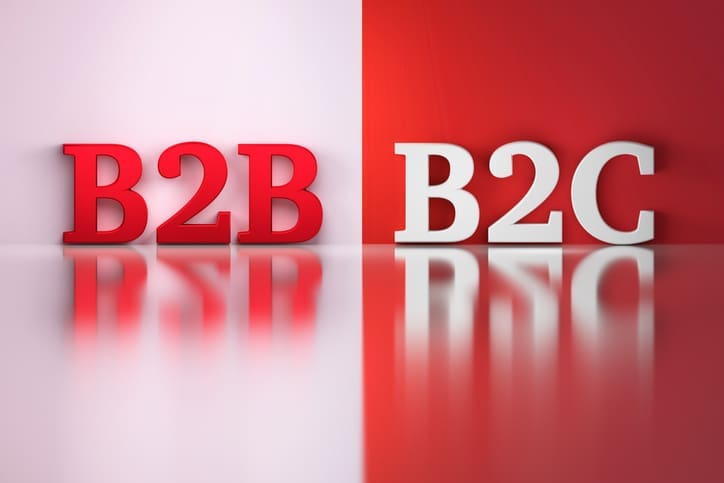Are You Making the Most Out of Your B2B Sales Funnel?
Tips for breaking down, building, and optimizing your sales funnel strategies to improve your conversion rates
Some people hear the term “marketing” and think of things like YouTube commercials or Instagram ads trying to sell them fashion or supplements or some other consumer product. And while that’s certainly a huge component of the marketing and sales industry, it doesn’t capture another important area: business-to-business (B2B) marketing.
If you’re a business trying to sell your products or services to other companies or businesses, basic marketing advice might not work as well for you. You have to optimize your strategies and sales tactics for your B2B market.
Let’s Start at the Start: What Is a Sales Funnel?
Sales funnels – sometimes also referred to as purchase funnels, customer funnels, marketing funnels, or AIDA (awareness, interest, desire, action) models – are essentially a visual way of depicting the path that takes someone from prospect to loyal customer. You start at the top with a wide net hoping to catch the awareness and attention of as many prospective customers as possible. As they advance down the funnel in stages, inevitably a certain percentage of prospects will drop away, but a well-built and optimized sales funnel will minimize that drop-off as much as possible. By the time you get to the narrow bottom of the funnel, you have converted customers.
How Are B2B Sales Funnels Different From B2C?
In a broad context, B2B and B2C are both functioning for the same goal: conversion and sales. But it would be incorrect to say that they’re the same. B2B funnels are longer and more complex than B2C funnels because the end-stage conversion often requires buy-in from multiple decision makers. You’re not just trying to sell your product or service to a single individual; you have to pitch it and sell it to an entire company, demonstrating why what you offer is the best fit for them.
So while the B2C funnels often consist of just four stages – awareness, interest, desire, action – B2B funnels have at least 6 stages, although it could be more depending on how you choose to break it down. We’re going to stick with the most commonly recognized 6 essential stages and dig into them a little more.

What Are the B2B Sales Funnel Essentials and How Do You Optimize Them?
Top of the Funnel
- Awareness – This is the very first starting point on your funnel, where prospects initially learn about your business and what you might have to offer. These prospects often have a pain point or want that they’re looking for solutions to.
- Optimization: Prospects are often going to Google in search of these solutions, which means that your keyword rankings and content marketing are especially important at this point. Things like Reddit responses, YouTube videos, podcasts, and other supplemental media can also boost name and brand recognition.
- Interest – They know of your company; maybe they don’t know much more than that, but it’s a good start. You are now tasked with harnessing that awareness and leveraging into a deeper interest in learning about your products and services. They want informative answers on who you are and why you should keep their attention.
- Optimization: This is your true first impression, so you need to ensure you’re putting your best foot forward. That looks like having a truly informative website with a clean, straightforward user experience. Highlighting strong reviews, product-centric articles, and webinars or convention/community participation are great additional tools, as is having clear, compelling email engagement campaign.

Middle of the Funnel:
- Consideration – At this point, the prospect likely has a shortlist of companies or businesses that could potentially solve their pain point and they’re digging into deeper consideration. More decision makers might be getting involved to assess their options, and this is when initial contact is most likely to happen. This is your first opportunity to start building the relationship.
- Optimization: Have some highly polished presentations and resources – like pricing and product comparisons, whitepapers, frequently asked questions – that you can quickly deliver on when they request more information. The clearer and more confident you are on what you can uniquely offer, the more that comes through to the prospect.
- Intent – The prospect’s list of potential partners is narrowing, and you’ve likely met and/or communicated with them at least once by this point. You might be the only remaining candidate for them at this point, or you may be up against one or two competitors. Prospects might need a formal presentation or product demonstration or other additional information, like contract language, to help make their decision.
- Optimization: That bit from the last bullet point about know what you can uniquely offer? It really comes in clutch here. You need to know who your direct competitors are, who you might be bidding against, and lean into the ways that you differ from them. Know who the decision makers are and try to speak directly to their questions or concerns. Be ready to demonstrate how you’ll handle things like onboarding, troubleshooting, and technical support.
Bottom of the Funnel:
- Evaluation/Decision – This is it. The crux point in the customer journey, when the decision makers at a prospective customer pool all the information they’ve collected and make a decision.
- Optimization: The biggest one at this point is ensuring you have clear calls to action. Prospects should know exactly what they need to do to move forward with you, and you should have the whole process set up to be as smooth and streamlined as possible.
- Purchase – Success! Your prospect is now officially a customer. But in a sense, the work has just begun because you want to retain the business you worked so hard to gain.
- Optimization: What do you have set up to nurture this relationship with your new customer? In addition to some of the more obvious things, like customer support, you should also have email campaigns, status calls, engagement tracking, and more, so you can consistently assess how the partnership is progressing.
Want to stay up to date with the news and resources from EdwardsSchoen?
Sign up for our monthly newsletter to stay in the know!
Anything Else to Know About B2B Sales Funnels?
A lot of the work of an effective sales funnel is done way before you even start using it. Make sure you know what your overarching goals are as a company; do deep competitor analysis to identify what sets you apart. Define who your ideal customer is and what needs or pain points you can help them with. This foundation will feed into every stage of the funnel and inform your next steps. It will help you with honing your website content and keyword targeting, allowing you to create content that strategically positions you as an expert and thought leader in your industry.
Harness the Power of the Funnel
Building out a B2B sales funnel can be a little daunting and a decent amount of work on the backend, but if done well, it can pay off in spades. It’s worth it to take your time and put in the foundational work in order to see improved conversion rates and expanded brand recognition.
If you’re interested in building a better B2B sales funnel but don’t want to take on the task alone, marketing partners like EdwardsSchoen bring the experience and expertise to make the whole process easier. Reach out to us if you want any more information or have additional questions.
